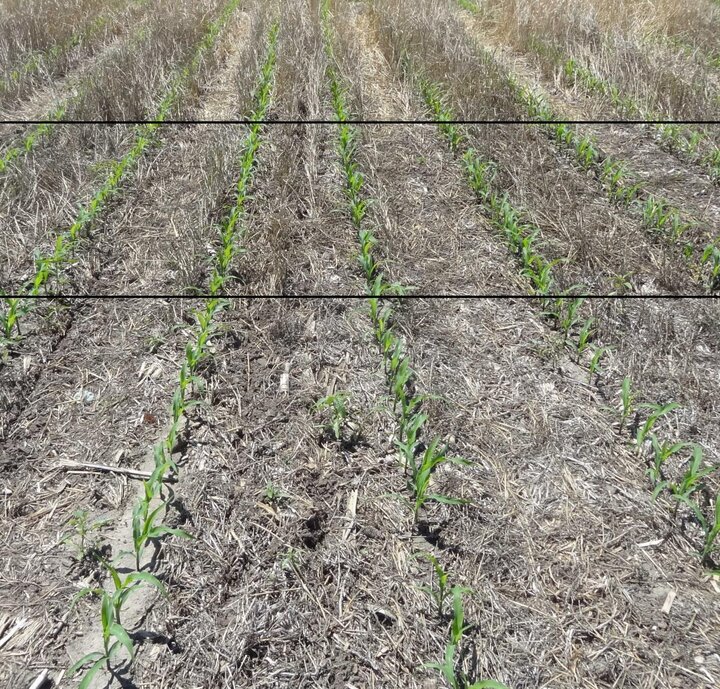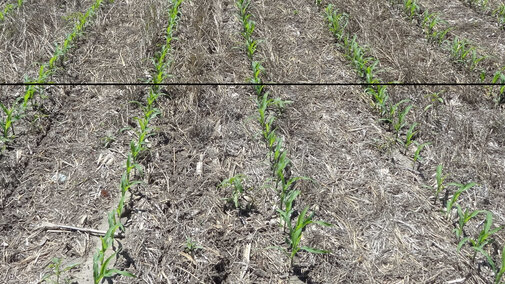Cereal rye has become a popular cover crop to reduce soil erosion and add carbon to the soil system. Producers often ask "What's the best time to terminate the rye to get the benefits of the cover crop while still conserving soil moisture for the cash crop?" They also ask about when it's safe to plant corn into rye residue as they’ve heard that it’s toxic to corn. Others are worried about an allelopathic effect on the growing crop as they have seen yellow corn plants emerge. With proper management, these potential problems can be minimized while taking advantage of the benefits of the cover crop.
When it comes to planting time, there is a chance of germination injury from the decaying rye residue. It may be due to the decaying green ooze that can interfere with germination of the corn seed if the first moisture taken into the seed has the leachate from the ooze. The worst time to plant corn is five to ten days after spraying the rye as the ooze leachate may be in the seed zone. To be safe, wait at least two weeks after spraying before planting corn, especially if there has been a rainfall event after the cereal rye started dying. Terminating rye earlier will conserve more soil moisture, but not result in much biomass production.
An alternative would be to plant first and spray a couple of days later so that the corn seed starts to germinate before the cereal rye dies. The rye uses some soil moisture while producing more biomass to protect and build the soil. This can also dewater wet soils in a rainy spring and provides some soil structural stability with the added rye roots to allow traffic on wet soils sooner.
Be sure to check with your crop insurance provider on the timing if you want to insure the corn crop. In established no-till systems in eastern Nebraska, you may have up to seven days after planting corn to terminate the cover crop; however, there is a risk that the weather conditions may not allow spraying in a timely matter. Further west, the cover crop may need to be killed several weeks before planting in order to conserve soil moisture. Under irrigation, the intervals may be different, depending on the crop and the location. Again, check with your crop insurance provider.
When planting into a cereal rye cover crop, the chance of germination injury is reduced as planting depth is increased. Some producers report that they are planting corn 2.5 to 3.5 inches deep and haven’t seen any germination injury. Also, the potential for injury is reduced when planting into moist soils, into continuous no-till soils with higher organic matter, and when the seed-vee is properly closed. While some producers use residue movers to get the rye residue off the row, many prefer to leave the residue over the row to reduce crusting and drying out of the seed zone. In addition, taller rye residue may wrap around the turning residue movers, creating problems at planting time.

More Information
Some producers increase their starter fertilizer rate to help get the corn off to a quicker start. Some extra starter nitrogen (30 to 50 lb/ac) may be needed for corn-on-corn and/or when planting into a rye cover crop as some nitrogen is tied up by the decaying corn stalks and rye residue, especially if the primary nitrogen application is broadcasted on the soil surface. The tied-up nitrogen is released to the soil system later as the residue decays, but the corn may be yellow and nitrogen deficient before this occurs, affecting the yield potential. This problem is greatly reduced if the nitrogen is injected into the soil rather than broadcast on the soil surface and when extra starter nitrogen is placed near the crop row at planting time. Some research indicates that the yellow corn is more likely the result of a nitrogen deficiency rather than allelopathy of the rye residue. This is especially observed with late applications of surface-applied nitrogen without enough rainfall to move it into the active root zone.
While planting decisions have already been made for this year, planting soybeans into a cereal rye cover crop avoids most of the problems with germination injury and early season nitrogen. However, timing of cover crop termination in relation to planting date still has to be considered for crop insurance purposes.

